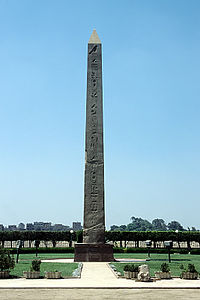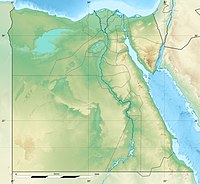
Back Heliopolis (antiek) Afrikaans أون Arabic هليوبوليس ARZ Heliopol Azerbaijani Геліопаль (Старажытны Егіпет) Byelorussian Хелиополис (Египет) Bulgarian Heliòpolis (antic Egipte) Catalan Heliopolis (arkiyolohiyang dapit sa Ehipto) CEB Iunu Czech Iunu Danish
Jwnw or Iunu | |
 Al-Masalla obelisk, the largest surviving monument from Heliopolis, pictured in 2001. | |
| Location | Egypt |
|---|---|
| Region | Cairo Governorate |
| Coordinates | 30°07′46″N 31°18′27″E / 30.129333°N 31.307528°E |
Heliopolis (Jwnw, Iunu; Ancient Egyptian: 𓉺𓏌𓊖, romanized: jwnw, lit. 'the Pillars'; Coptic: ⲱⲛ; Greek: Ἡλιούπολις, romanized: Hēlioúpolis, lit. 'City of the Sun') was a major city of ancient Egypt. It was the capital of the 13th or Heliopolite Nome of Lower Egypt [citation needed] and a major religious centre. Its site is within the boundaries of Ain Shams and El Matareya, districts (kism) in northeastern Cairo.
Heliopolis was one of the oldest cities of ancient Egypt, occupied since prehistoric Egypt.[1] It greatly expanded under the Old and Middle Kingdoms but is today mostly destroyed, its temples and other buildings having been scavenged for the construction of medieval Cairo. Most information about the ancient city comes from surviving records.
The major surviving remnant of Heliopolis is the obelisk of the Temple of Ra-Atum erected by Senusret I of Dynasty XII. It still stands in its original position, now within Al-Masalla in El Matareya, Cairo.[2] The 21 m (69 ft) high red granite obelisk weighs 120 tons (240,000 lbs) and is believed to be the oldest surviving obelisk in the world.[3] Under Augustus, the Romans took the Obelisk of Montecitorio from Heliopolis to Rome, where it remains. The two smaller obelisks called Cleopatra's Needles, in London and New York, also came from the city.
- ^ Dobrowolska; et al. (2006), Heliopolis: Rebirth of the City of the Sun, American Univ in Cairo Press, p. 15, ISBN 9774160088.
- ^ Griffith, Francis Llewellyn (1911). . In Chisholm, Hugh (ed.). Encyclopædia Britannica. Vol. 19 (11th ed.). Cambridge University Press. p. 945..
- ^ "obelisk". www.britannica.com. Retrieved 2021-08-25.
